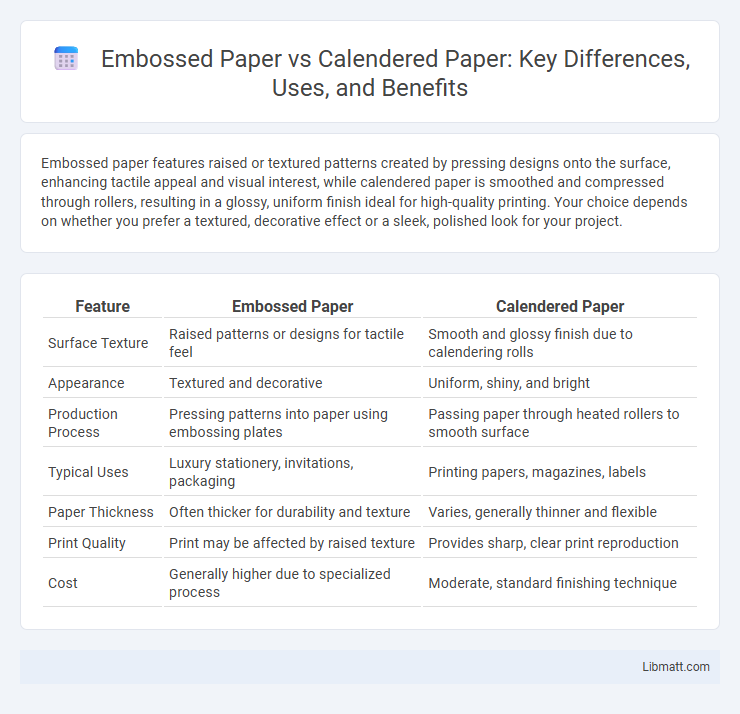Embossed paper features raised or textured patterns created by pressing designs onto the surface, enhancing tactile appeal and visual interest, while calendered paper is smoothed and compressed through rollers, resulting in a glossy, uniform finish ideal for high-quality printing. Your choice depends on whether you prefer a textured, decorative effect or a sleek, polished look for your project.
Table of Comparison
| Feature | Embossed Paper | Calendered Paper |
|---|---|---|
| Surface Texture | Raised patterns or designs for tactile feel | Smooth and glossy finish due to calendering rolls |
| Appearance | Textured and decorative | Uniform, shiny, and bright |
| Production Process | Pressing patterns into paper using embossing plates | Passing paper through heated rollers to smooth surface |
| Typical Uses | Luxury stationery, invitations, packaging | Printing papers, magazines, labels |
| Paper Thickness | Often thicker for durability and texture | Varies, generally thinner and flexible |
| Print Quality | Print may be affected by raised texture | Provides sharp, clear print reproduction |
| Cost | Generally higher due to specialized process | Moderate, standard finishing technique |
Understanding Embossed Paper
Embossed paper features a raised or textured surface created by pressing a pattern into the paper fibers, enhancing tactile and visual appeal for packaging and specialty printing. This technique increases paper thickness and stiffness, providing a premium, luxurious feel compared to calendered paper, which is smoothed by rollers to achieve a glossy, uniform finish. Embossed paper is ideal for invitations, business cards, and upscale branding where texture and depth contribute to a memorable customer experience.
What Is Calendered Paper?
Calendered paper is created by passing the paper web through heated rollers, producing a smooth and glossy surface finish ideal for high-quality printing. The calendering process compresses the fibers, enhancing brightness, density, and gloss, which makes it suitable for magazines, brochures, and labels. Your choice between embossed and calendered paper depends on whether you need textured tactile effects or a sleek, polished look.
Key Differences Between Embossed and Calendered Paper
Embossed paper features raised or recessed patterns created by pressing a textured plate onto its surface, enhancing tactile appeal and visual depth ideal for invitations and luxury packaging. Calendered paper undergoes a smoothing process through heated rollers, resulting in a glossy, uniform finish that improves printability and brightness, commonly used for magazines and brochures. The key differences lie in texture and finish: embossed paper emphasizes three-dimensional texture, while calendered paper prioritizes smoothness and sheen for vibrant color reproduction.
Texture and Surface Finish Comparison
Embossed paper features a raised or recessed design created through heat and pressure, giving it a distinct tactile texture and a visually rich surface. Calendered paper undergoes a smoothing process by passing through rollers, resulting in a glossy, flat finish with minimal texture. The choice between embossed and calendered paper depends on desired tactile appeal and surface treatment, with embossed paper offering more texture and calendered paper providing a sleek, polished look.
Printing Results: Embossed vs Calendered Paper
Embossed paper creates raised or recessed designs that add tactile dimension and depth to your prints, enhancing visual impact but requiring precise ink application to avoid smudging. Calendered paper undergoes a smoothing process through heated rollers, resulting in a glossy, uniform surface that produces sharp, vibrant printing with consistent ink adherence. Choosing between embossed and calendered paper affects your print's texture and color saturation, influencing the overall presentation quality.
Applications and Uses of Embossed Paper
Embossed paper is widely used in packaging, greeting cards, and luxury invitations for its tactile texture and aesthetic appeal, enhancing brand perception and consumer experience. Common applications include stationery, wallpaper, and decorative book covers where raised patterns create a premium look and feel. This paper type also finds use in business cards and labels, providing a distinctive and memorable design element compared to smooth calendered paper.
Common Uses for Calendered Paper
Calendered paper is commonly used for high-quality printing projects such as magazines, catalogs, brochures, and flyers due to its smooth, glossy finish that enhances image clarity and color vibrancy. It is also favored in packaging applications, especially for labels and luxury boxes, thanks to its uniform surface and improved printability. Compared to embossed paper, calendered paper offers a sleek, polished look ideal for visual appeal in marketing and promotional materials.
Durability and Handling of Each Paper Type
Embossed paper features a raised pattern that enhances tactile durability, making it resistant to wear and ideal for packaging or decorative uses that require frequent handling. Calendered paper offers a smooth, glossy finish achieved through a mechanical process, which improves printability but may be more susceptible to surface scratches and creases during handling. When durability is crucial, embossed paper provides better resistance to physical damage, while calendered paper excels in delivering a sleek appearance with moderate durability.
Cost Implications: Embossed vs Calendered
Embossed paper typically incurs higher production costs due to the additional machinery and time required for creating raised patterns, affecting your overall packaging budget. Calendered paper, which undergoes smoothing and gloss enhancement through rollers, offers a more cost-effective option while maintaining a sleek finish. Choosing between embossed and calendered paper depends on your balance between premium tactile appeal and budget constraints.
Choosing the Right Paper for Your Project
Embossed paper features raised patterns that add texture and a tactile dimension, making it ideal for luxury invitations and high-end packaging. Calendered paper, smoothed by rollers during manufacturing, offers a glossy, uniform finish suited for magazines and brochures requiring vibrant print clarity. Your project's purpose and desired aesthetic should guide your choice between the tactile elegance of embossed paper and the sleek appearance of calendered paper.
embossed paper vs calendered paper Infographic

 libmatt.com
libmatt.com